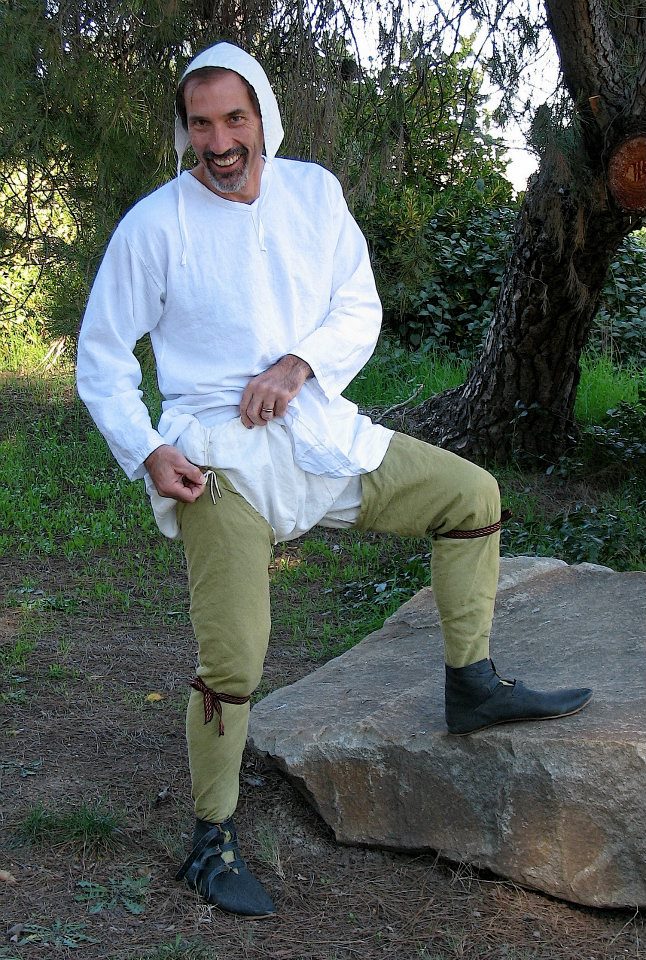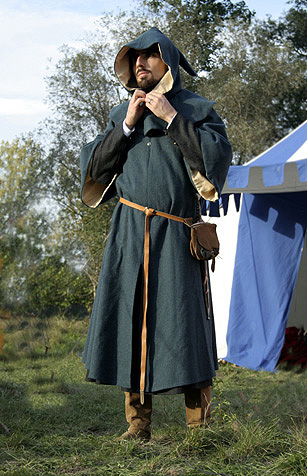- Clothing patterns are relatively simple - Nearly every garment can be constructed from rectangles and right triangles
- Fitting clothing from this period requires little tailoring
- Clothing construction can be accomplished with only 1 basic sewing stitch
- Clothing from this period is quite comfortable
- You can buy clothing from this period off-the-rack
Medieval clothing, like modern clothing, served several roles. It preserved the wearer's modesty, protected them from their environment, kept them warm, and displayed their social status. Clothing typically was worn in layers, which provided great utility in carrying out these roles. Typically, the layers that touched the skin were made from undyed or bleached linen, while outer layers were constructed from dyed wool. The colors could be fairly bright, and the idea of medieval people dressed only in shades of dull brown certainly is not reflected in images of medieval people.
 |
| Images of Peasants laboring in the Maciejowski Bible (13th century) showing typical medieval outfits |
As mentioned above, underwear garments were worn next to the body and were constructed from undyed or bleached linen. These layers needed to be washed most frequently and linen is a strong material that is relatively easy to wash.
| Image of a laboring peasant from the Maciejowski Bible |
 |
| A modern recreation of medieval underwear layer including braies, shirt, and coif. Chausses are also shown (in green). Image from Historic Enterprises |
Shirt: A linen shirt or under-tunic was worn to cover the torso and arms. They were constructed in much the same way as the tunic, extending to around knee level and including long sleeves.
Coif: A coif is a small linen cap that was worn on the head to cover the hair. It served to protect hats and hoods from the dirt and oils found in the hair.
Outerwear:
Outerwear included chausses, a tunic, and frequently a hood. These garments were historically constructed from dyed wool fabric, however within the SCA they are frequently constructed from dyed linen. While wool is actually surprisingly breathable and cool in the summer, linen is cooler and also cheaper, which is why it is popular among members of the SCA, as many events are held outdoors in the summer.
 |
| Rear View of the Bocksten Man outfit (circa 1350) showing outer layers. Image from: http://www.kostym.cz/Anglicky/1_Originaly/01_Goticke/I_01_84.htm |
Chausses: Chausses or hose were worn to cover the foot and lower leg. They are essentially thigh-high socks that are pulled up and over the bottom of the braies. Unlike modern socks which are knitted, medieval hose were cut from woven cloth on the bias (diagonally) to provide some degree of stretch and were sewn together. They were held up by being tied to the waistband of the braies or a separate belt and/or by garters worn at the knee.
 |
| Modern recreation of outfit from Manesse codex showing a long tunic, belt, pouch, hood, and shoes. Image from: http://www.kostym.cz/Anglicky/8_Krejcovstvi/18_Justyna/VIII_18_22A.htm |
 |
| Modern reconstruction of Bocksten outfit showing tunic, hood, and coif. Image from: http://www.kostym.cz/Anglicky/8_Krejcovstvi/04_Vera/VIII_04_11.htm |
Hood: In the middle ages, hoods were typically a separate garment from cloaks. Medieval hoods typically had a "tail" called a liripipe and included a mantle that covered the top of the shoulders. Sometimes the edge of the mantle was cut into various shapes, or dagged, as a form of decoration.
Accessories:
Shoes: Shoes were typically constructed of leather and may or may not have had a pointed toe. Shoes from this time period were turnshoes meaning that they were sewn together like an inside-out bag and were then turned so that the seams were left on the inside. Ankle boots seem to be the most commonly worn type of shoes during this period.
Belt: Medieval belts could be leather or fabric. They were typically rather narrow (~1" wide) and were fastened with a buckle.
Belt Pouch: Pouches served as a way of carrying small items like money, dice, small trinkets, etc. They were often suspended from the belt, but sometimes they were worn underneath the tunic for added security. Both kidney-shaped and trapezoidal pouches are good choices for this period.
Hat: Medieval hats served the same purposes as modern hats, sun protection, warmth, rain protection, and decoration. Both straw and felted hats seem to exist during this period, and there are portraits of laborers wearing hats that are very similar to modern straw hats. Felted hats were made in various shapes including the "bycocket" popularized by Robin Hood.
Cloak: Cloaks were worn for added warmth and served as medieval rain gear. Cloaks were essentially a blanket, however circular or semi-circular cloaks are more fashionable than the rectangular cloaks seen in the early middle ages. As mentioned above, hoods tended to be worn as a separate garment. Cloaks were fastened with a metal clasp called a brooch.
Shoulder Bag: While one might describe the shoulder bag as a purse, they were worn by both men and women and would have served to help carry items that were too large to fit in a belt pouch.
 |
| Modern reproduction Shoulder bag aka "Pilgrim Bag" Image from: https://battleofwisby1361.wordpress.com/2013/05/29/the-medieval-pilgrimage-reenacted/ |
Knives: Knives were a commonly used tool for medieval people and were frequently carried in sheaths suspended from the belt. It may have been common for people to carry two knives, with one being specifically meant for use as an eating utensil and the other serving a more utilitarian purpose. Medieval people carrying two knives can be seen in various visual sources and the Bocksten man was also found with two knives.
 |
| Image of various reproduction medieval knives, daggers, and even a spoon. Image from http://www.todsstuff.co.uk/theenglishcutler/index.htm |
Daggers: Certainly not every medieval person carried a dagger at all times, but those who were travelling or who were members of the martial class did seem to wear them. "Ballocks" daggers are popular choices amongst reenactors in part due to their distinctive shape, but other dagger styles such as the rondel dagger are also available.